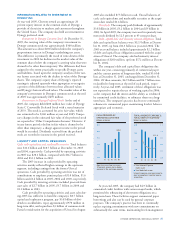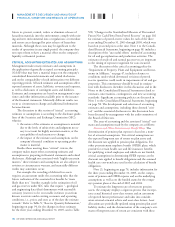Chevron 2005 Annual Report Download - page 46
Download and view the complete annual report
Please find page 46 of the 2005 Chevron annual report below. You can navigate through the pages in the report by either clicking on the pages listed below, or by using the keyword search tool below to find specific information within the annual report.
MANAGEMENT’S DISCUSSION AND ANALYSIS OF
FINANCIAL CONDITION AND RESULTS OF OPERATIONS
44 CHEVRON CORPORATION 2005 ANNUAL REPORT
taxes for all years under examination or subject to future
examination.
Global Operations Chevron and its affi liates conduct
business activities in approximately 180 countries. Areas
in which the company and its affi liates have signifi cant
operations or ownership interests include the United States,
Canada, Australia, the United Kingdom, Norway, Denmark,
France, the Netherlands, the Partitioned Neutral Zone
between Kuwait and Saudi Arabia, Republic of the Congo,
Angola, Nigeria, Chad, South Africa, the Democratic Repub-
lic of the Congo, Indonesia, Bangladesh, the Philippines,
Myanmar, Singapore, China, Thailand, Vietnam, Cambo-
dia, Azerbaijan, Kazakhstan, Venezuela, Argentina, Brazil,
Colombia, Trinidad and Tobago and South Korea. The com-
pany’s Caspian Pipeline Consortium (CPC) affi liate operates
in Russia and Kazakhstan. The company’s Tengizchevroil
affi liate operates in Kazakhstan. Through an affi liate, the
company participates in the development of the Baku-Tbilisi-
Ceyhan (BTC) pipeline through Azerbaijan, Georgia and
Turkey. Also through an affi liate, the company has an inter-
est in the Chad/Cameroon pipeline. The company’s Petrolera
Ameriven affi liate operates the Hamaca project in Venezuela.
The company’s Chevron Phillips Chemical Company LLC
(CPChem) affi liate manufactures and markets a wide range
of petrochemicals on a worldwide basis, with manufacturing
facilities in the United States, Puerto Rico, Singapore, China,
South Korea, Saudi Arabia, Qatar, Mexico and Belgium.
The company’s operations, particularly exploration and
production, can be affected by changing economic, regula-
tory and political environments in the various countries
in which it operates, including the United States. As has
occurred in the past, actions could be taken by host govern-
ments to increase public ownership of the company’s partially
or wholly owned businesses or assets or to impose additional
taxes or royalties on the company’s operations or both.
In certain locations, host governments have imposed
restrictions, controls and taxes, and in others, political condi-
tions have existed that may threaten the safety of employees
and the company’s continued presence in those countries.
Internal unrest, acts of violence or strained relations between
a host government and the company or other governments
may affect the company’s operations. Those developments
have, at times, signifi cantly affected the company’s related
operations and results and are carefully considered by man-
agement when evaluating the level of current and future
activity in such countries. Refer to page 30 for a discussion
of the company’s transition agreement with Petróleos de Ven-
ezuela, S.A. (PDVSA), the Venezuelan state-owned petroleum
company, to convert contracts for the Boscan and LL-652
operating service agreements into an Empresa Mixta.
Suspended Wells The company suspends the costs of
exploratory wells pending a fi nal determination of the com-
mercial potential of the related crude oil and natural gas
fi elds. The ultimate disposition of these well costs is depen-
dent on the results of future drilling activity, or development
decisions or both. If the company decides not to continue
development, the costs of these wells are expensed. At
December 31, 2005, the company had approximately $1.1
billion of suspended exploratory wells included in properties,
plant and equipment, an increase of more than $400 million
from 2004 and an increase of less than $600 million from
2003. Of the increase in 2005, about $300 million was the
year-end suspended well balance for the former-Unocal oper-
ations. The year-end 2005 balance primarily refl ects drilling
activities in the United States, Nigeria and Indonesia.
The future trend of the company’s exploration expenses
can be affected by amounts associated with well write-offs,
including wells that had been previously suspended pend-
ing determination as to whether the well had found reserves
that could be classifi ed as proved. The effect on exploration
expenses in future periods of the $1.1 billion of suspended
wells at year-end 2005 is uncertain pending future activities,
including normal project evaluation and additional drilling.
Refer to Note 20, beginning on page 73, for additional
discussion of suspended wells.
Equity Redetermination For crude oil and natural gas
producing operations, ownership agreements may provide for
periodic reassessments of equity interests in estimated crude
oil and natural gas reserves. These activities, individually or
together, may result in gains or losses that could be material
to earnings in any given period. One such equity redetermi-
nation process has been under way since 1996 for Chevron’s
interests in four producing zones at the Naval Petroleum
Reserve at Elk Hills, California, for the time when the
remaining interests in these zones were owned by the U.S.
Department of Energy. A wide range remains for a possible
net settlement amount for the four zones. Chevron currently
estimates its maximum possible net before-tax liability at
approximately $200 million. At the same time, a possible
maximum net amount that could be owed to Chevron was
estimated at about $50 million. The timing of the settle-
ment and the exact amount within this range of estimates
are uncertain.
Accounting for Buy/Sell Contracts In the fi rst quarter
2005, the Securities and Exchange Commission (SEC) issued
comment letters to Chevron and other companies in the oil
and gas industry requesting disclosure of information related
to the accounting for buy/sell contracts. Under a buy/sell
contract, a company agrees to buy a specifi c quantity and
quality of a commodity to be delivered at a specifi c location
while simultaneously agreeing to sell a specifi ed quantity
and quality of a commodity at a different location to the
same counterparty. Physical delivery occurs for each side of
the transaction, and the risk and reward of ownership are
evidenced by title transfer, assumption of environmental risk,
transportation scheduling, credit risk and risk of nonperfor-
























